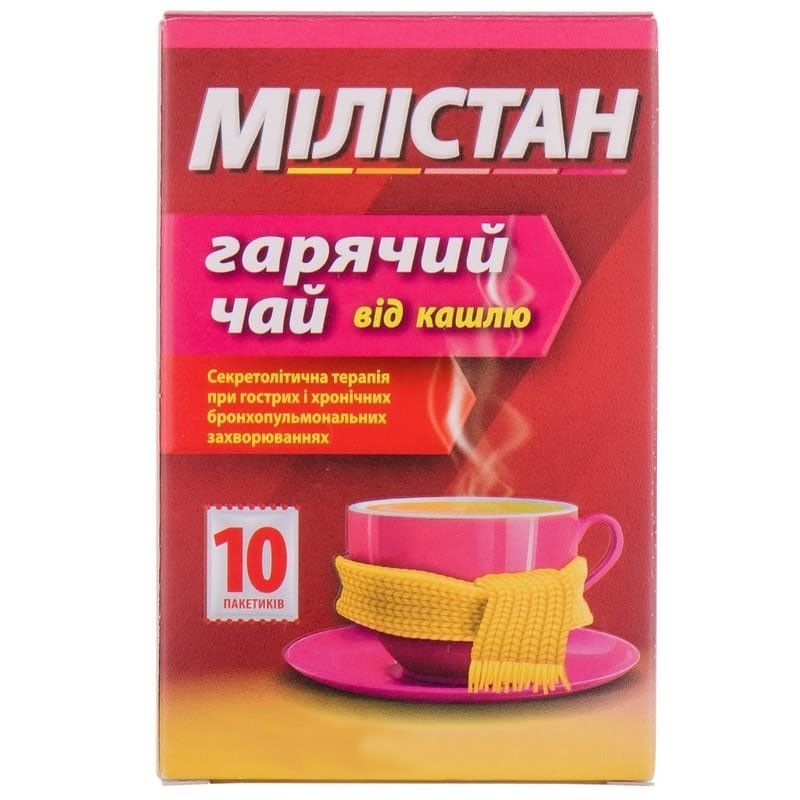



 Secure and encrypted payment processing
Secure and encrypted payment processing We ship to over 40 countries including the USA, UK, Europe, Australia and Japan
We ship to over 40 countries including the USA, UK, Europe, Australia and Japan Guaranteed refund or reship if you haven't received your order
Guaranteed refund or reship if you haven't received your orderThe powder for the oral solution "Milistan hot tea for cough" is used for the following indications: secretolytic therapy for acute and chronic bronchopulmonary diseases associated with impaired bronchial secretion and weakened progress of mucus.
1 sachet (6 g) contains (active ingredients):
Excipients: sucrose, anhydrous citric acid, tartaric acid, sodium citrate, dye quinoline yellow (E 104), lemon essence, aspartame (E 951).
The drug should be used by dissolving the contents of one sachet in one glass of boiled hot water (not boiling water), taken hot.
Adults and children over 12 years old - one sachet 3 times a day.
The drug should not be used for longer than 4-5 days without consulting a doctor.
Ambroxol hydrochloride crosses the placental barrier. Animal studies have not revealed direct or indirect harmful effects on the course of pregnancy, development of the embryo / fetus, childbirth or postnatal development. Based on the clinical experience with Ambroxol after the 28th week of pregnancy, no harmful effects on the fetus have been identified. However, the usual measures of taking medications during pregnancy should be observed. Especially in the first trimester of pregnancy, Ambroxol is not recommended. A lack of vitamin C in the diet of pregnant women can be dangerous for the fetus, however, its use in high doses can also negatively affect the development of the fetus, therefore, ascorbic acid is prescribed only when the expected benefit to the mother outweighs the potential risk to the fetus.
Ambroxol hydrochloride passes into breast milk. Ascorbic acid passes into breast milk, so during the period of breastfeeding, vitamin C is taken only under the supervision of a doctor. Thus, the drug is not recommended for use during lactation.
Preclinical studies do not indicate a direct or indirect harmful effect on fertility.
Do not use for children under 12 years old.
There is no data on the effect on the reaction rate when driving vehicles or other mechanisms. A study of the effect on the reaction rate when driving vehicles or other mechanisms was not conducted.
To date, there are no reports of cases of overdose in humans. Ambroxol is well tolerated after parenteral administration in doses up to 15 mg / kg / day and after oral administration up to 25 mg / kg / day. After an overdose of Ambroxol, no severe signs of intoxication were observed. Symptoms are possible: stomach pain, nausea, vomiting, diarrhea, short-term anxiety.
By analogy with preclinical studies of ambroxol, excessive overdose can lead to hypersalivation, urge to vomit and lower blood pressure.
With an overdose of ascorbic acid, nausea, vomiting, bloating and abdominal pain, itching, skin rashes, increased irritability occur. With prolonged use in high doses, the following are possible: inhibition of the function of the insular apparatus of the pancreas (hyperglycemia, glucosuria), impaired glycogen synthesis; sodium and fluid retention, impaired zinc metabolism, damage to the glomerular apparatus of the kidneys, the formation of urate and / or oxalate stones in the kidneys and urinary tract, renal failure, crystalluria, thrombocytosis, myocardial dystrophy, hyperprothrombinemia, erythrocytopenia, neutrophilic leukocytosis.Impaired copper metabolism in patients with glucose-6-phosphate dehydrogenase deficiency can cause erythrocyte hemolysis, hemolytic anemia.
Urgent measures such as inducing vomiting and gastric lavage are generally not indicated and should be used in case of acute intoxication. The treatment is symptomatic and supportive.
On the part of the immune system and skin and subcutaneous tissue: skin rash, urticaria, eczema, angioedema, itching, anaphylactic reactions (including anaphylactic shock), other hypersensitivity reactions; severe skin lesions: Stevens-Johnson syndrome and toxic epidermal necrolysis (Lyells syndrome) and acute generalized exanthematous pustulosis).
From the cardiovascular system: arterial hypertension, myocardial dystrophy.
From the side of the nervous system: headache, sensation of fever, irritability, sleep disturbance, dysgeusia (taste disorder), fatigue.
From the gastrointestinal tract: irritation of the mucous membrane of the digestive tract, heartburn, nausea, decreased sensitivity in the oral cavity; vomiting, diarrhea, dyspepsia, abdominal pain, dry mouth; constipation, salivation; dry throat.
From the respiratory system, chest and mediastinal organs: decreased sensitivity in the pharynx; rhinorrhea; shortness of breath (as a symptom of a hypersensitivity reaction).
From the urinary system: damage to the glomerular apparatus of the kidneys, crystalluria, the formation of urate, cystine and / or oxalate calculi in the kidneys and urinary tract, renal failure, dysuria.
From the endocrine system: with prolonged use in high doses - damage to the insular apparatus of the pancreas (hyperglycemia, glucosuria), impaired glycogen synthesis before diabetes.
On the part of the blood and lymphatic system: thrombocytosis, erythrocytopenia, thrombosis, neutrophilic leukocytosis, hyperprothrombinemia; in patients with deficiency of glucose-6-phosphate dehydrogenase, blood cells can cause erythrocyte hemolysis, hemolytic anemia.
From the side of metabolism: metabolic imbalance of zinc, copper.
Common disorders: fever, reactions from the mucous membranes.
Other: palpitations, dizziness.
Store in the original packaging at a temperature not exceeding 25 ° C, out of the reach of children.
Shelf life is 2 years.